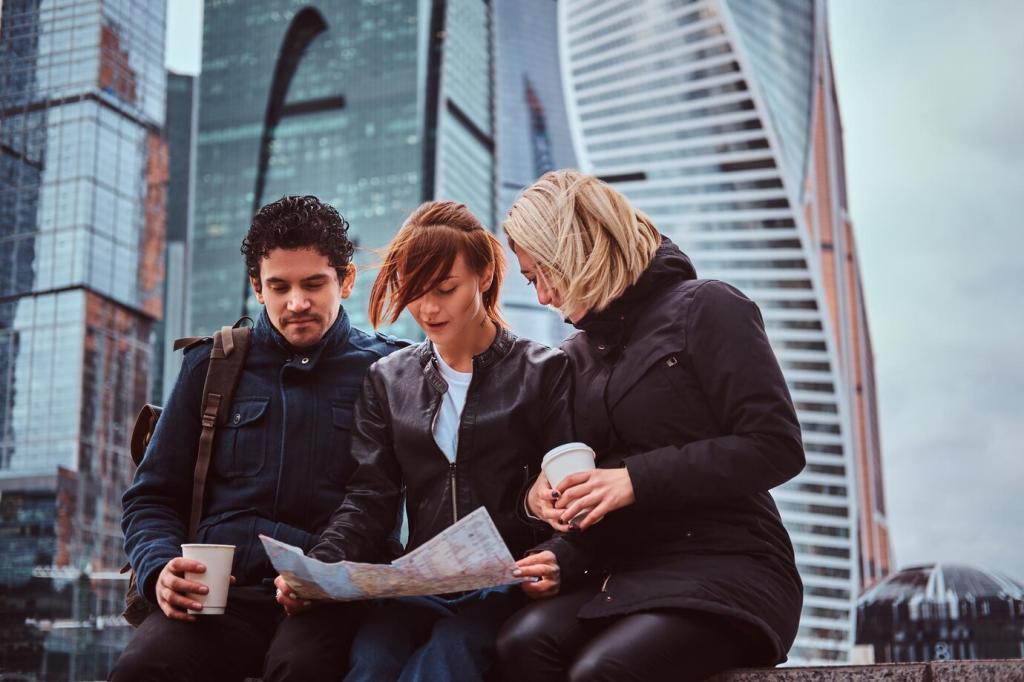
Capturing Urban Landscapes: Tips for City Photography
Selected theme: Capturing Urban Landscapes: Tips for City Photography. Step onto the sidewalk with curiosity, learn to tame light and lines, and turn everyday streets into memorable frames. I once hesitated at a crosswalk and missed a rainbow reflection; since then, I pre-compose while I wait. Subscribe and share your favorite intersection so we can explore it together next week.
Golden and blue hours between towers
Use golden hour to warm glass and stone, then switch to blue hour for cool balance. Meter for highlights, watch reflections, and let streetlights create depth across layered avenues.
Neon nights and mixed color temperatures
Urban light mixes LEDs, tungsten, and neon, so embrace contrast instead of fighting it. Shoot RAW, set a neutral anchor, and artistically lean warm or cool for mood.
Compositions That Guide the Eye
Seek diagonals in tram tracks and shadows, then place your vanishing point intentionally. Step sideways to avoid visual mergers, exaggerate depth, and guide viewers through layered facades and intersecting avenues.
Compositions That Guide the Eye
Use a lamppost, bollards, or a parked bike to frame a skyline; slightly blur foreground at wide aperture to add intimacy and invite the eye inward.
Compositions That Guide the Eye
Train stations beg for symmetry; center boldly, then let one moving element break perfection. That deliberate imbalance adds energy, honesty, and a lived-in feeling to architectural order.
Gear That Works on the Street
A 24mm or 28mm prime keeps distortion manageable yet expansive. Move your feet, pre-focus at hyperfocal distance, and stay discreet; fewer choices encourage stronger, faster compositional decisions.
Gear That Works on the Street
A 70-200mm compresses layers of balconies, signage, and haze into graphic patterns. Isolate rhythm, flatten perspective creatively, and reveal silhouetted stories hidden between distant rooftops and repeating windows.
Gear That Works on the Street
Carry a small travel tripod or clamp for long exposures, plus ND and a soft-edged graduated filter. A circular polarizer tames glare without sterilizing reflections that make cities feel alive.


Motion as a Storytelling Tool
Use a three to ten second exposure to sketch traffic desire lines through a junction. Wait for buses to turn, add a static monument, and your trail becomes narrative punctuation.
Motion as a Storytelling Tool
Start around 1/15s, follow the subject smoothly, and fire in short bursts. The blurred background stitches motion across storefronts, while faces and handlebars stay surprisingly readable and human.
High, Low, and Unexpected Vantage Points
Rooftops and terraces responsibly
Always secure permission for rooftops or terraces, respect residents, and avoid risky edges. Official viewpoints at museums or hotels often deliver safer height with compelling lines and sweeping context.
Ground-level intimacy for bold scale
Drop to knee height to let crosswalk markings loom large and lead the frame. Clever perspectives at curb level turn ordinary shopfronts into towering stages buzzing with layered life.
Windows, reflections, and stairwells as frames
From parking garages to spiral staircases, frame scenes with railings and windows. Reflections in polished stone or bus shelters multiply storylines without clutter, offering cinematic depth within limited space.
Editing to Honor the City's Character
Fixing geometry and horizons first
Start with lens profiles, vertical transforms, and careful cropping to remove tilted keystones. A level horizon and believable lines make bold compositions feel intentional rather than accidental.
Color grading for night clarity
Separate hues using HSL and color wheels; protect skin tones and tungsten highlights while cooling shadows. A little selective saturation around signage can sing without drowning subtle textures or mood.
Cleaning distractions with care
Use heal and clone gently to remove gum spots, sensor dust, and stray cones. Keep scars and patina that tell history, because texture is often the city’s most honest voice.
